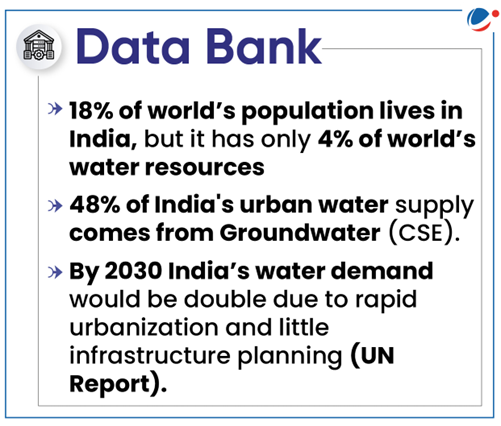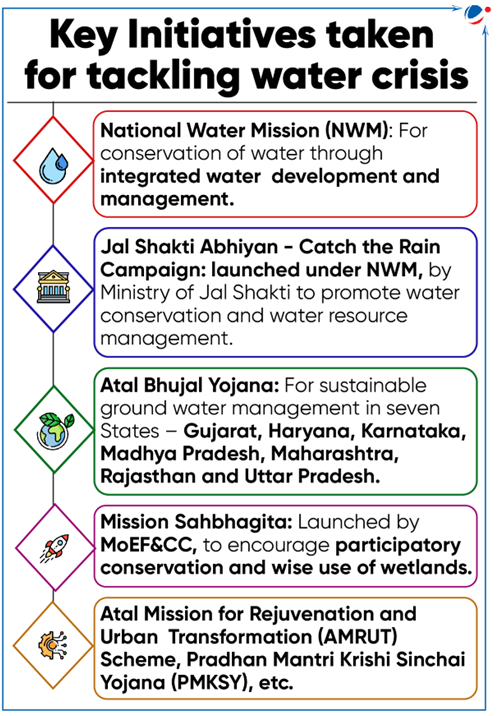Why in the news?
Bengaluru is facing one of the worst water crises in recent years due to poor rainfall.
Urban Water Crisis
- Water crisis refers to a situation where there is inadequate access to clean and safe water for various needs due to factors like pollution, overuse, and poor management.
- Water resources becoming scarce because of drought conditions as aggravated by climate change has been referred to as ‘Day Zero’.
- Day Zero means water levels in dams supplying water to the city are critically low; it does not imply that there is no water in dams.
- Cape Town in 2018 and Chennai in 2019 have experienced ‘Day Zero’.
- Day Zero means water levels in dams supplying water to the city are critically low; it does not imply that there is no water in dams.
- Water crisis is a key hindrance in achieving sustainable Development Goals (SDGs) particularly SDG6 which calls for clean water and sanitation by 2030.

Reasons behind the Urban Water Crisis
- Unplanned urbanization: The rapid erosion of green cover, encroachment of water bodies and overexploitation of natural resources have strained water availability in the city.
- Unplanned concretization prevents water from percolating into the soil and recharging the water table.
- In Bengaluru, the number of lakes has decreased from 262 in 1961 to about 81 currently
- Unplanned concretization prevents water from percolating into the soil and recharging the water table.
- Pollution of water bodies: For example, large water bodies like Bellandur Lake (Bengaluru) have become heavily polluted due to industrial effluents and untreated sewage flowing into them.
- Over-extraction of groundwater: In the most populated cities, groundwater levels have drastically decreased over the past two decades which further exacerbates the problem of water crisis.
- Poor water supply infrastructure: Many urban areas lack proper water supply infrastructure, including distribution networks, treatment plants, and storage facilities.
- Because of these, leakage happens which in turn results in high non-revenue water (i.e., water "lost" before it reaches the customer).
- Climate change: Erratic monsoons and a rise in the frequency and intensity of floods and droughts could adversely affect the accessibility and availability of water.
- Aquifer system: Groundwater resources in South India are not able to sustain for very long in the event of a prolonged dry spell.
- South India has a very different kind of aquifer system which is very rocky that don’t hold a lot of water.

Way Forward
- Nature-Based Solutions: Promoting green-blue infrastructure and restoration of wetlands can help absorb excess water during floods and store water during droughts.
- Community based solutions: The community play a critical role in efficiently managing water (preventing wastage, pollution and leakage), wastewater reuse, improving groundwater levels, etc.
- For example, Orange County in California (US) has employed a community education campaign to create acceptance of the recycled water.
- Community participation is also central to India’s Jal Jeevan Mission.
- Regulatory measures: Regulatory policies should ensure the adoption of sustainable urban water management practices e.g., Rainwater harvesting (RWH), Grey-water recycling, and wastewater treatment.
- For, example, in Tamil Nadu RWH is compulsory in all new buildings.
- Use of Technology: Technology could be helpful in leakages detection, water quality monitoring, and facilitate targeted remediation actions.
- For example, Clean Water AI is a device that uses a deep learning neural network to detect dangerous bacteria and harmful particles in water.
- C2C learning in water governance: The potential of city-to-city (C2C) learning to address water issues is largely untapped. One option that cities have is to start networking and building learning alliances with other cities.
- For example, the LOTUS-HR program is a collaborative project between the Netherlands and India to treat sewage water in Delhi.
- Leveraging the private sector: For example, Tata Steel had commissioned the creation of the Dimna Lake in Jamshedpur.
- Additionally, to reduce freshwater consumption, they conform to a water audit and have real-time, online monitoring.






